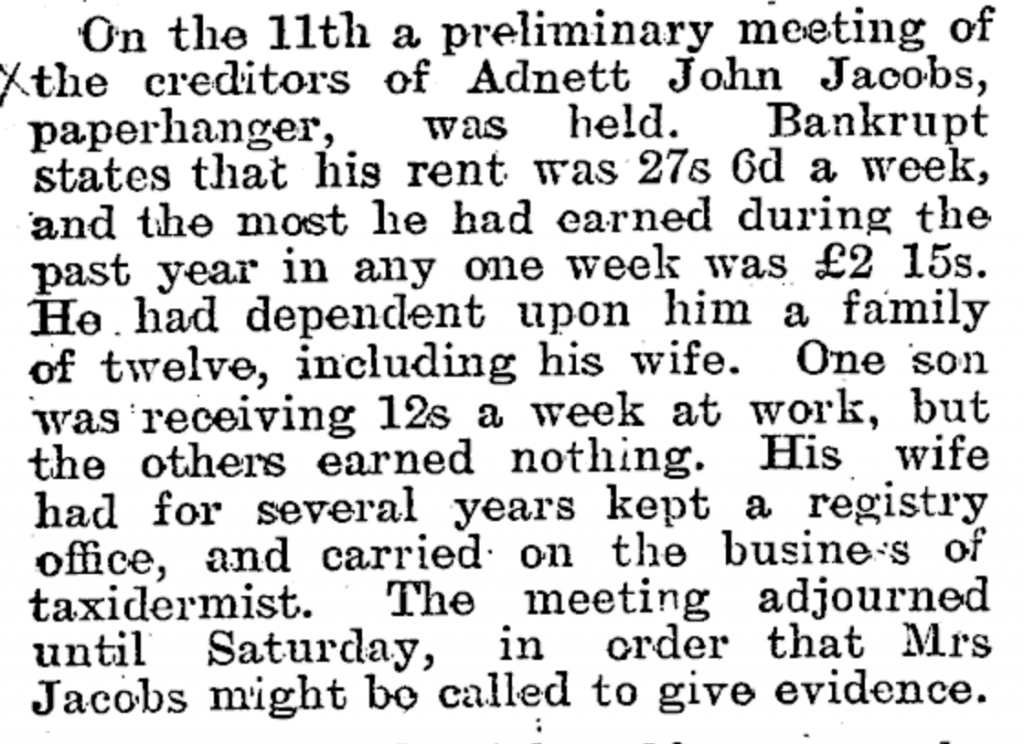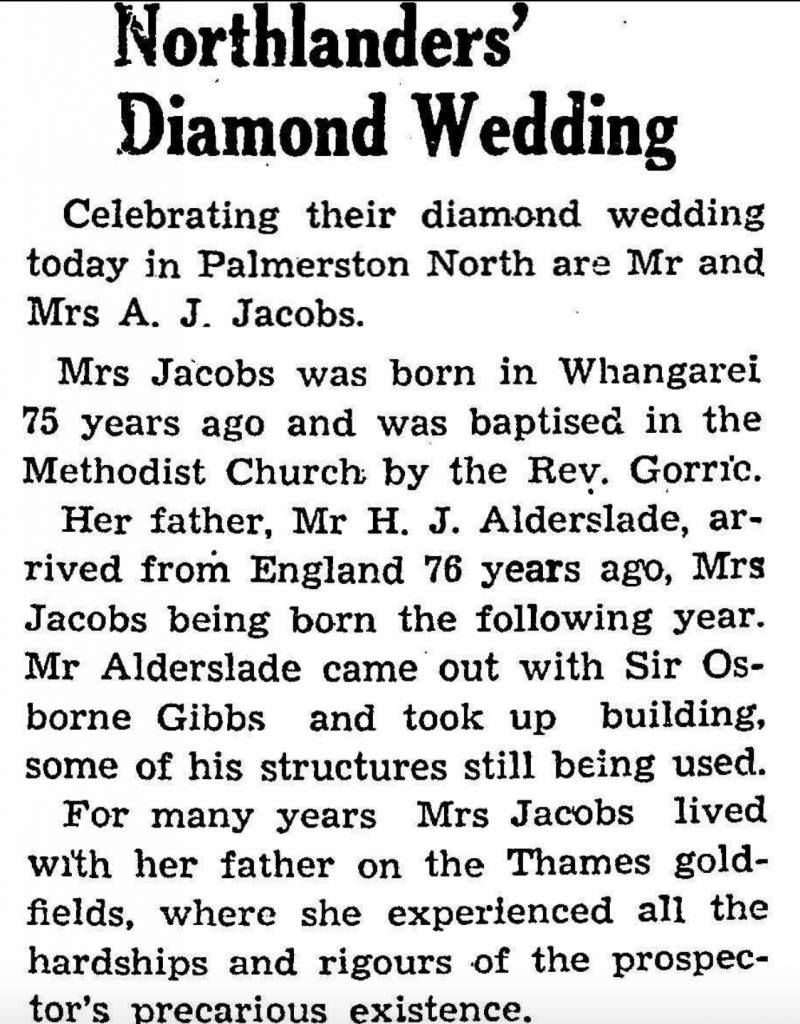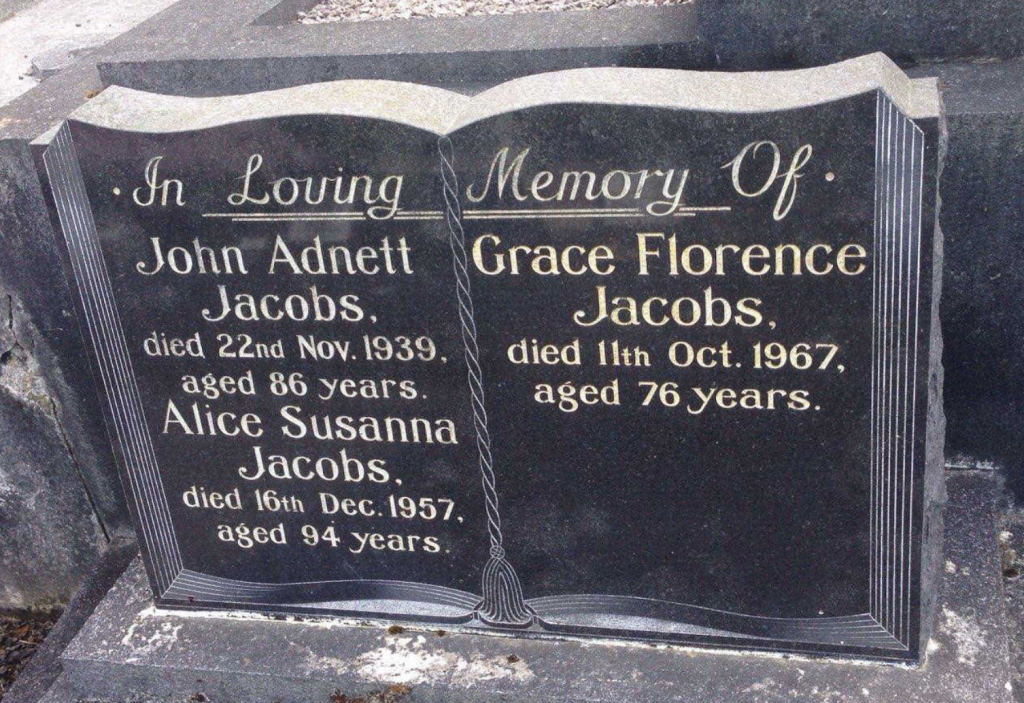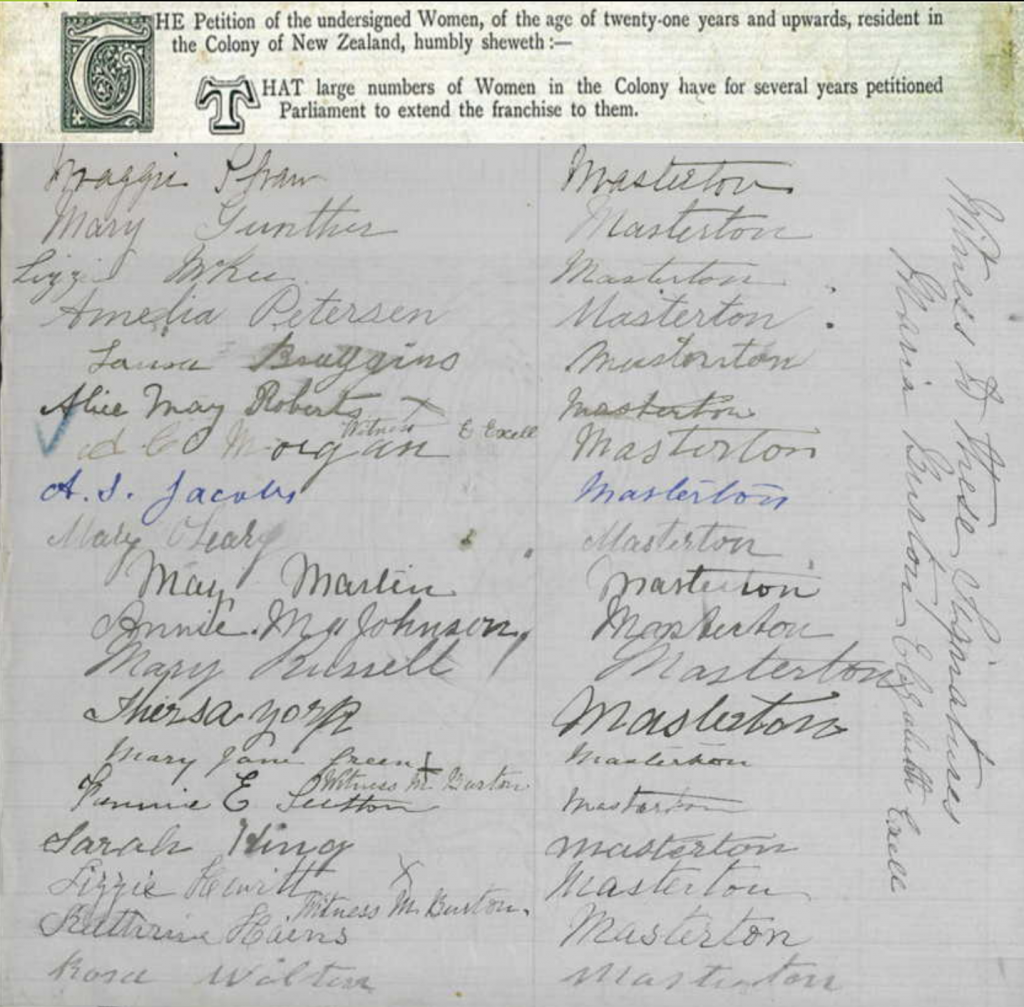Adnett John JACOBS & Alice Susannah ALDERSLADE
Relationship to me: Great Great Grandparents (paternal)
Adnett was born May 30th, 1853, in Newington, Surrey, England, and the youngest of five children. Adnett died on November 22nd, 1939, in Palmerston North, NZ. Alice was born at Vine Street, Whangarei, on January 31st, 1863. She died on December 16th, 1957, in Palmerston North. Adnett and Alice had a taxidermy business, first in Masterton, and then they subsequently moved to Palmerston North.

John Adnet Jacobs (1853) bought himself out of the British Army for ‘one shilling’ (ten cents) to join his family who were emigrating to New Zealand. The family travelled to New Zealand on the ship “The Forfarshire”. Alice was a remarkable woman, who at the age of 6 walked with her family from Whangarei to Auckland (97 miles) to avoid a Maori raid. At the time of their wedding, John was already established as a taxidermist and paperhanger – a curious combination of trades. Alice had trained as a “naturalist” in London, England.
Together they trained several of their fourteen children in taxidermy and travelled throughout New Zealand collecting and preparing skins of native birds. These were sold to American and European institutions and collectors. When the bird numbers were depleted they moved on. They established businesses in Masterton, Palmerston North, Nelson and Dunedin. In addition to taxidermy, the businesses included furrier and rabbit skin export.
Source: FROM THE BOOK THIS FAMILY OF OURS:
http://www.oocities.com/tarnz4d/Musicalinstruments-pg44.html
In 1905, Adnett was declared bankrupt, with the newspaper reporting that he had 12 dependents including his wife.

By 1933, the fur business had collapsed, and Alice also became bankrupt.
FURRIER FILES. With a deficiency of £9O 4s 9d in her estate, Mrs A. S. Jacobs, furrier, of Palmerston North, has filed a petition in bankruptcy. At a meeting of creditors called for yesterday, there were present tho D.O.A. (Mr C. E. Dempsy), Messrs A. E. Wright (Dominion’Publishing Company), N. Abraham (Brice’s Ltd.), H. R. Thomas (Fur Trading Company). The statement of assets and liabilities showed unsecured creditors at £384 12s 3d and secured creditors at £275. Assets comprised £2OO stock, £l9 7s Gd shop fittings and 1 £350 value of property in West Street, Palmerston North. In a written statement bankrupt said she came to Palmerston North 12 years ago from Dunedin and commenced business on her own account in Main street as a furrier. She had only a limited amount of capital. She purchased a house in West street from Mr Newbold for £5OO and paid a deposit of £5O. She later raised a first mortgage on the property from the State Advances and gave Mr Newbold a second mortgage for the balance. She had since reduced the mortgages to £164 and £lll respectively. For some years business was quite successful until in 1927 she had a fire in the shop and practically the whole of the stock valued at £2OO was destroyed. There was no insurance. As business prospects in Main street west were poor she then took where sho had been carrying on business up to the present on a three years’ lease at £2 10s per week. Upon the expiration of the term she continued in the shop as a monthly tenant. During the last three years business had steadily declined and latterly she had been unable to pay her business accounts and rent got into arrears. She was unable to pay the arrears of Tent and tho landlord distrained on her stock. She could make no offer to her landlord or other creditors and there seemed no prospect of a recovery in business. She was 71 years of age, in poor health and regretted being unable to make an offer. Answering questions by the D.0.A., bankrupt said it was all of 12 months since she realised sho could not pay all her debts in full. (Source: PapersPast)
Alice’s family were some of the first early settlers in Whangarei. The first colonial settler in Whangarei was William Carruth, a Scottish trader who arrived in 1839. Gilbert Mair and his family joined Carruth six years later. By 1842 though, the early settlers farms were plundered for transgressions of tapu, and all the settlers fled, most never returning. It was not until 1855 that a small town began to develop, based on the kauri gum trade.
Te Whanga-a-Reipae – The Waiting Place of Reipae
Whangarei derived its name from a Mäori legend about the journey of Reitu and Reipae.
These two high born twin sisters from a powerful Waikato tribe travelled to the far north on a legendary falcon (Te Karearea) to visit Ueoneone, a handsome young chief from Ngapuhi.
Ueoneone and his people hoped that marriage to the twin sisters would strengthen tribal
alliances between Waikato and Ngapuhi. As the falcon flew north from the Waikato, the
sisters argued with each other over sharing Ueoneone as their common husband.
Arriving at Onerahirahi (Onerahi), Reipae feigned sickness and asked the falcon to rest for a time on the shores of this beautiful harbour adjacent to Mt. Manaia. During the stop over, Reipae heard her sister Reitu make scathing remarks about her and this caused Reipae to give up her quest to share Ueoneone with her sister. Following this incident, Reipae encouraged Reitu to continue the journey without her, and Reitu flew on alone northwards to Te Tomo pa and eventually married the northern rangatira (Chief) Ueoneone. Reipae remained at Onerahi to await her brothers and other kinfolk who were travelling overland to Northland in support of the sisters. Reipae remained in the Onerahi area and eventually married Tahuhu Potiki, a local chief. Whangarei Harbour was named after her – the original name being Te Whanga-a-Reipae (The Harbour of Reipae) – where Reipae waited for her people.
Source: Whangarei New Settlers Guide (http://www.wdc.govt.nz/CommunitySafetyandSupport/SettlementSupport/Documents/New-Settlers-Guide.pdf)
Ray (Adnett’s youngest son) was appointed taxidermist and Head of the Display Department, Canterbury Museum, Christchurch. After 31 years he was awarded the MBE (Member of the British Empire) “….for meritorious contribution to taxidermy and museum display” by Sir Dennis Blundell, Governor General. Among many other displays, Ray constructed the original “Christchurch Street” and the “Hall of New Zealand Birds” that was opened in 1956 and may still be seen to this day. Ray was a particularly talented man. In addition to being an outstanding taxidermist he constructed the foreground and painted the huge backdrops for all the habitat groups.
Ray’s youngest son Terry (1938) learned taxidermy at his father’s elbow. While Ray worked on clients’ trophies Terry skinned wrecked birds picked up on New Brighton Beach. Even before leaving school his ambition was to become New Zealand’s leading taxidermist, as his father before him. Terry took up a position as Senior Zoological Technician, University of Canterbury, where he met his wife Eileen. During this period he travelled to Antarctica as part of the University of Canterbury’s Biological Unit Expedition to Ross Island. He joined his father at the Canterbury Museum as a taxidermist and preparator. By 1968, Terry had decided to broaden his international career by accepting a post of Chief Technician at the National Museum of Tanzania, Dar es Salaam, where he remained for two years. He followed this with a study tour of North America, Europe and the British Isles.
By 1970 Terry decided to enter business on his own account. He established the company of Terry Jacobs Limited early that year and brought to bear all of his experience and talents which had been honed over the previous two decades. It’s no exaggeration to claim he revolutionised the whole industry by setting new standards which have now come to be accepted as a national benchmark for taxidermy in New Zealand. In 1974, to underscore the new company’s presence, he took three gold and two silver medals out of the five classes available to taxidermists at the New Zealand Exhibition of Hunting.
David Jacobs, Terry and Eileen’s youngest son, worked his way through college as a part time taxidermist in his father’s studio. He graduated Bachelor of Forestry Science from Canterbury University and travelled soon after to Arkansas, USA on an Ottenheimer Scholarship. It was while visiting the many hunting and taxidermy friends his family had made over the years that he decided to embark on a career in taxidermy.
In September 1994 David received a business development grant to explore the United States taxidermy market, to visit their studios and study the latest developments. He visited many world class facilities including the Denver Natural History Museum, Milwaukee Public Museum and the Field Museum, Chicago. David is a keen hunter and outdoorsman.
Source: The Taxidermist Ltd., Four Generations
DIAMOND WEDDING.
MR AND MRS W. S. JACOBS,
A diamond wedding anniversary was celebrated in Palmerston North on Saturday, when Mr and Mrs W. S. Jacobs [sic], of 29 West Street, completed 6O years of married life. Mrs Jacobs, who was formerly Miss Alice Aldorslade, celebrated her 70th birthday on January 21. She was born at Mangarere during the Waikato wars and still remembers the constant fear of the Maoris under which her family lived. During the gold rush they moved to Thames, where Mrs Jacobs remembers the historic tidal wave about the time of her sixth birthday. Her next home was in Wellington, where her father was engaged in the building trade. Wellington was mostly populated by Maoris, Mrs Jacobs told a Standard reporter, and Courtenay Place was just a collection of Maori whares. Mr Jacobs came to New Zealand at the age of 16 in the Forfarshire, landing at Nelson. Later he moved to Wellington, where he met his future wife, and the wedding took place on January 29, 1879. Owing to the illness of the minister they were married by the registrar at the old Courthouse on Lambton Quay. Mr Jacobs was engaged in the fur trade, and Mrs Jacobs, who was 16 years old at the time of the wedding, immediately set to work to learn her husband’s work. They later set up a business in Palmerston North, where Mr Jacobs worked at taxidermy while Mrs Jacobs attended to the rest of the business. Although both retired several years ago, Mrs Jacobs still continues her work, which she finds an interesting occupation. There were 14 children of the marriage, of whom twelve survive. They are Messrs R. Jacobs (Palmerston North), G. Jacobs (Wellington), V. Jacobs (Wellington), R. Jacobs (Papatoetoe), H. Jacobs (Christchurch), E. Jacobs (Palmerston North), C. Jacobs (Otaki), Mesdames W. Greenbank (Wellington), E. J. Haynes (Christchurch), C. Procter (Palmerston North), and Misses K. Jacobs (New Plymouth), and G. Jacobs (Palmerston North). There are 45 grandchildren and 15 great-grand-children. Almost of the family were, present on Saturday at the celebration, which was a quiet one owing to the ill-health of Mr Jacobs, who has reached the great age of 80 years. Among those present were Pastor J. A. Tyrrell-Baxter, who congratulated the happy couple, and Mrs A. Tucker, a niece of Mrs Jacobs. Many congratulatory messages and telegrams were received, including one from the Prime Minister, and several handsome gifts. in spite of a strenuous life, Mrs Jacobs is still very active and delights to talk of her many interesting memories of the early days which, she says, she recalls more vividly than later events. She expressed the opinion that school children should be taught more about the Maoris and the early life of the country, and she feels sure that they would find it an interesting study. Her own grandchildren listen with great attention to her stories of pioneer days. Mrs Jacobs hopes to revisit Thames some day.
Source: PapersPast (1939)





Adnett John JACOBS
b. 30 May 1853
d. 22 Nov 1939
m. 29 Jan 1879 in Wellington (Alice)
Mother: Jane Garrett NORLEY
Father: William George JACOBS
Siblings:
Jane Charlotte
George William
William Norley
Joseph
Alice Susannah ALDERSLADE
b. 31 Jan 1863
d. 16 Dec 1967
Mother: Elizabeth Matilda GREY
Father: Henry James Jackson ALDERSLADE
Siblings:
Elizabeth Matilda
Charles Henry
Jenny Jackson
Emma Jane
Henry Jackson
Emily May
Ada Jane
Children of Adnett and Alice
Rose Ethel (1879-1977)
Alice Jane (1881-1967)
John William Henry “Jack” (1882-1929)
Nellie Eveline Grey (1884-1921)
George Adnett Bell (1886-1970)
Henry Walter Benson “Harry” (1888-1970)
Grace Florence Fowler (1891-1967)
Ivy Myrtle (1893-1967)
Roy Stanley Baldwin (1895-1965)
Victor Leonard Darwin (1897-1984)
Eva Muriel Victoria (1900-1967)
Eric Huia Edward Kitchner (1902-1973)
Clarence Hector (1904-1986)
Raymond Joseph Wadman MBE (1906-1974)
Sources
Adnett’s Death Notice: https://paperspast.natlib.govt.nz/newspapers/MS19391122.2.2?query=adnett+jacobs&snippet=true
Adnett’s Bankruptcy Notice: https://paperspast.natlib.govt.nz/newspapers/NZMAIL19050719.2.118?query=adnett+jacobs&snippet=true